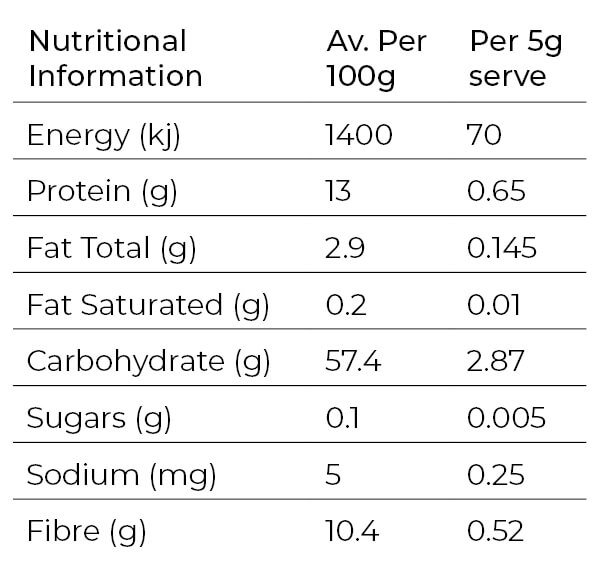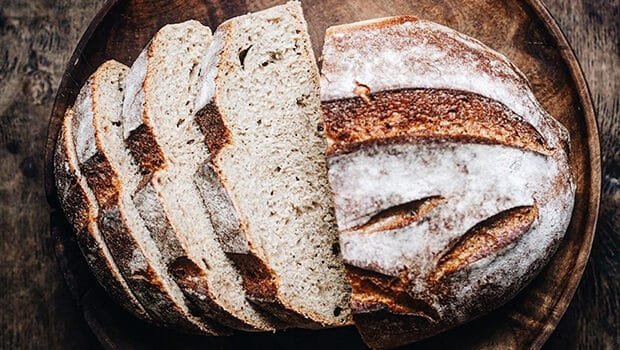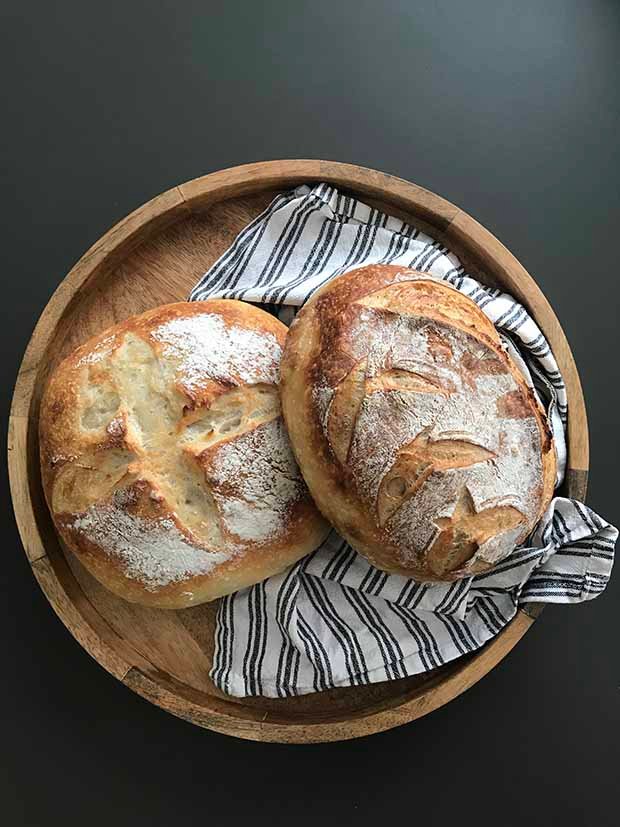The Truth About Strong Bread Flour In the USA
‘Strong’ bread flour in America is the same as anywhere else around the world. What is different across the globe is the labelling and terms used to describe different bread flours, so not all bread flour packets contain strong bread flour. And this can vary depending on where you live – the United States or elsewhere. It can also vary depending on the company and their interpretation or use of the words ‘bread flour’. Yes. It’s true! I guess that’s why you’re here. You’re thinking of embarking on the sourdough bread journey and doing some research, or you’ve started and your sourdough bread isn’t working. This was me and let me share with you another piece of the puzzle – not all flours are equal and neither are their labels.
I make sourdough bread, so using proper ‘strong’ bread flour is essential. If you’re reading this making yeasted loaves of bread, the information will still apply. You will get better loaves with more rise, however, using yeast is more forgiving than sourdough and you will be able to use flour that is not entirely ‘strong’.
Why does strong flour make a difference?
Cake flour is for cakes, so they are soft and crumbly whereas bread flour is for bread, making it crunchy and chewy. Even though the two flours look the same inside the packet, they yield very different results depending on what you’re baking. If you’ve ever tried making a cake with bread flour or bread with cake flour, you will know that they are completely different. A chewy cake is about as exciting as a crumbling loaf of sourdough!
You can read all about the necessity of using strong bread flour for making sourdough here. But in short, the flour contains more protein, causing the gluten bonds to bind together more strongly (when wet), which produces great stretchability. Without it, the gluten bonds are short and break easily – causing a crumbling effect and in the case of sourdough bread, flat sourdough.
Strong bread flour in its truest form is the same across the globe. What changes is company classifications and using the words ‘strong bread flour’ on labelling when the flour itself might only just be scraping the characteristics of strong bread flour, making it useful for yeasted bread, but difficult for making a good loaf of sourdough bread.
Adding to the confusion are helpful YouTube tutorials that use language suitable in their country but not in others. In the United States (US) I have heard a lot of people recommend using All-Purpose Flour for making sourdough bread and feeding a sourdough starter. In Australia, this is closely akin to cake flour. I don’t live in America to be able to verify the strength of their All-Purpose flour, but thankfully, I don’t need to and neither do you need to live here in Australia to understand ours either.
There is a simple way of establishing ‘strong bread flour; whether it’s white, rye, spelt, wholemeal etc. And it has nothing to do with the name the company has printed on the packet, marketing jargon or in what aisle you found the flour in the supermarket.
The key to understanding true strong bread flour in any country, including the United States, is in reading the nutrition label. This one little piece of mandatory information helps you identify what that flour is suitable for – cakes, all-purpose baking or bread-making whether you are in America, Australia or even travelling abroad.
WHAT IS STRONG BREAD FLOUR?
Apart from the type of grain used, such as rye, wheat or spelt, the biggest difference between various types of flour is the level of protein in it which affect the gluten. Gluten is the elastic band of baking and determines how texture and structure is formed. The strands can be soft and short in items like cake, or strong and stretchy, like in sourdough bread. Hence why flours are often described as soft or hard (strong) flour.
Low protein flours are soft because they have less gluten and vice versa, high protein flours contain more of this stretchy stuff, making them a strong flour.
So which do you think is more suitable for bread making?
If you said “Ummm… the high-protein flour, so the elastic band of gluten is more stretchy??” You would be 100% correct! This is strong bread flour.
SO, WHAT DOES THAT LOOK LIKE WHEN IT COMES TO STRONG BREAD FLOUR IN AMERICA?
Exactly the same as it world-wide. The protein qualities for different baking needs don’t change depending on where you live. As mentioned, what changes is the labelling. In some instances, the labelling doesn’t reflect the true qualities of the flour but is defined by the company labelling it. With bread flour isn’t often based on its suitability with yeast and a bread machine, not homemade sourdough bread.
A QUICK LOOK AT PROTEIN CONTENT IN FLOUR
Here, I will teach you how to choose flour based on what you’re making, and not what’s labelled on the packet.
Best protein levels in flour for:
Cakes and pastries: LOW protein (under 8%)
General baking: MEDIUM protein (9-12%)
Breads: HIGH protein (13+%)
You would think then, all flour would be labelled like this:
8% (and under) Protein: ‘Cakes and pastries flour’
9-12% Protein: ‘All-purpose flour’
13%+ Protein: ‘Bread flour‘
However, this is not the case. This is what differs around the world and, why some bread flours – as labelled – in Australia, are not true bread flours. I have seen protein levels vary from 8% to 14% with the product baring ‘Bread Flour’ on the packet.
Even worse are bread mixes. They are not ‘worse’ for making yeasted bread, no, they can make some fantatic bread, but bread mixes in Australia often use flours at the low end of protein levels (8%) and compensate by adding bread enhancers to the mix. The protein content on the nutritional table also shows the protein level for the entire mix, not just the flour, so it includes seeds etc which will boost the reading and protein level for you, but won’t be accessible to the sourdough cultures which need it.
Cake flour is usually labelled as cake flour but it’s worth checking the nutritional panel on the side of the packet if you’re wanting a true cake flour. You may find it’s actually all-purpose flour labelled as cake flour for marketing purposes, aiming to reach the home baker. For cake flour look for the protein content be around 8% or less. This is 1.28oz per pound (0.08lb per pound) or 8g per 100g.
All-purpose flour is designed to be a good all-rounder and is often a 50/50 mix of low and high protein flours (soft and strong). All-purpose flour does not include the wheat germ, which contains oil, so this flour generally has a longer shelf life than say, wholemeal. Again, this makes it more suitable for general baking. Anything labelled all-purpose in Australia, generally is a mix of both cake and bread flour, making it great for general use and you may not need to check the protein content as it won’t matter for general uses. The protein content should be between 9-12%.
This brings us to…
BREAD FLOUR
Some all-purpose flours in the United States and Canada, have a fairly high protein level, and is suitable for making bread, however… the flour is labelled all-purpose, like All-purpose flour in Australian, only we Aussies, can’t use it for making bread. Confusing hunh? To make it easy – you can’t judge flour by the labelling culture. You need to read the nutritional content and work out the protein level.
Bread flour has more protein content than all the other flour, being 13% or more. This is how you know the flour is truly strong bread flour.
True bread flour is made of ‘hard’ wheat, meaning it has more gluten, that elastic band of baking that gives you a strong stretchy structure, puffing your bread high and wide, while still holding its shape.
If you use cake flour or all-purpose to make bread, your loaf will be floppy and dense. It won’t have the strength required to rise (and stay full-bodied), no matter whether you bake that loaf in Australia, Austria or Uganda. Or whether the flour was called ‘bread flour’ on the packet.
For true bread flour, look for 13% protein or more which is 2.08oz per pound or 13g per 100g. The flour could be wheat, rye, wholemeal, spelt or other. It can also be a blend of these flours. The method is the same. Check the nutritional panel for the protein level.
EXAMPLE: NUTRITIONAL TABLE SHOWING PROTEIN CONTENT

*13g of protein per 100g of flour is 13% or 2.08oz per pound
The protein content will give away whether or not the flour is suitable for making bread, even when the name on the packet says ‘Bread Flour’.
WHERE TO BUY STRONG BREAD FLOUR IN THE USA
Because I am in Australia, I don’t have access to bricks and mortar stores in the USA. But if you prefer not buy online, any of the following products will also be available in stores, you just might have to ask around to find out which ones.
AMAZON – Online. May be free delivery for Prime.
Unbleached & White Bread Flour
Cairnspring Mills Organic Espresso Artisan Bread Flour 13-14% Protein. (25lb)
Giusto’s Vita-Grain High Performer High Protein Unbleached Bread Flour 13-13.5% Protein. (2lb x 12)
King Arthur, 100% Organic Unbleached Bread Flour, Non-GMO 12.7% Protein. (2lb x 12)
Marriage’s Organic Strong White Bread Flour 13.4% Protein (1kg)
Marriage’s Very Strong Canadian White Flour 14.9% Protein (1.5kg)
Bob’s Red Mill Unbleached Artisan Bread Flour 13.8% Protein (5lb)
Bob’s Red Mill Unbleached Artisan Bread Flour 13.8% Protein (5lb x 4)
King Arthur Organic Bread Flour 13.3% Protein (5lb)
Cento Anna Napoletana Tipo “00” Extra Fine Flour 13.3%. (11lb) Pizza. Pasta. Bread
*Not great for beginner (using at 100%) Flours containing fine bran, such as White Heritage Flour and wholemeal flours, absorb more water than their white counterparts. For my regular recipes add an extra 60g water per loaf. These flours have high protein levels but a different gluten structure due to the wholegrain. Doughs tend to be more coarse, sticky and not as stretchy when used at 100%. They also have less oven spring and a slightly denser, but still soft interior (crumb). You can mix these flours with white bread flour if you want a larger, lighter loaf. To start, try 80% white and 30% wholegrain.
Einkorn, Rye, Spelt^
Organic Einkorn Bread Flour 13.3% Protein. (32oz)
Whole Wheat Einkorn Flour by Jovial 12.5% Protein (starting to get low – consider using Vital Wheat Gluten) (32oz)
Bob’s Red Mill Organic Dark Rye 13.3% Protein. (20oz)
Arrowhead Mills Organic Spelt Flour 14.3% Protein. (22oz)
Arrowhead Mills Organic Spelt Flour 14.3% Protein. (22oz x 6)
One Organics Organic Sprouted Spelt Flour 13.% Protein. (32oz)
Sprouted Spelt Flour 13.3% Protein. (80oz x 4)
Vita White Spelt Flour 13.3% Protein. (5lb)
Vita White Spelt Flour 13.3% Protein (25lb)
^Spelt is naturally high in protein, however, it will produce a flatter loaf due to less gluten. White spelt will produce a soft open interior. Wholemeal will be denser and flatter still. Both can be mixed with wheat bread flour for a higher rise if desired. I suggest starting with 80% white and 20% spelt see what you think and go from there. Any proportion is ok however spelt flour responds to water differently so the more spelt in the mix, the wetter your dough will be with the same amount of water. A wet dough is not an issue, it’s just not for beginners. It can be difficult to work with, For a 100% spelt loaf, that is easy to work with and has no kneading, see my recipe here.
Vital Wheat Gluten
Bob’s Red Mill, Vital Wheat Gluten Flour 75-80% Protein (22oz)
Bob’s Red Mill Vital Wheat Gluten Flour 75-80% Protein (20oz x 4)
Larissa Veronica Vital Wheat Gluten 75% Protein (16oz)
Whole Foods Gluten (500g)
Other Stores
Breadtopia High Protein Bread Flour (13.5%)
MAKE YOUR OWN (OR BOOST) BREAD FLOUR WITH VITAL WHEAT GLUTEN
Vital Wheat Gluten can transform inferior flour into something fairly magical. I have been using it to boost bread flours that are at the lower end of the protein scale with noticeable improvement. A little goes a long way! So if you are limited in with options for bread flour. not all is lost. You can make your own, with whatever flour you have available.
Follow this guide to match the amount of Vital Wheat Gluten you need for the flour you are using. See: How to add Vital Wheat Gluten to sourdough bread
Where to get VItal Wheat Gluten
Australia: I’ve found the cheapest online is from Amazon AU or try health food stores.
All other countries also try Amazon worldwide or your local health food store.
MAKE SOURDOUGH BREAD THE EASY WAY
If you’re new to sourdough or bread making and are looking for an easy way to dip your toe in the water of artisan baking without the blood sweat and tears of the initial learning curve, you might like to try our unique no-knead sourdough process. It’s designed for the first loaf of sourdough to work for even the greatest novice. One proviso – you need a viable sourdough starter.
Use your own sourdough starter and follow the traditional recipe or low-maintenance (6-week feeding cycle).
If you don’t have a sourdough starter or are having trouble with it, just buy one. I have two options, based on how much effort you want to put in. Purchasing a sourdough starter is equally authentic and will shave weeks (and even months) off the maturing process and spare you from all the hassles that come with troubleshooting the variables! It took me 18 months and dozens of failed loaves to get this ship sailing! It’s worth it. Trust me. Sail from the start. I’ve put a lot of work into the method and the sourdough starter – purely so you don’t have to. And because this is all about Beautiful Living Made Easy, here’s the beautiful catch – with this one you don’t have to make or upkeep a sourdough starter.
If you never want to upkeep a sourdough starter you could also try Pantry sourdough starter.
How can I make sourdough without keeping a sourdough starter?
I turn my 14-year-old sourdough starter into dormant sourdough flakes. You keep the flakes in your cupboard and use 5g to grow an (almost) instant sourdough starter when you want to bake. It takes 2-3 days depending on temperature and roughly 2 minutes of handling. Pantry Sourdough Starter is a sourdough starter that’s always on-hand, without regular feeding, trial or error. I am passionate that anyone, anywhere should be able to make sourdough bread easily.
All my processes and sourdough starters make the same authentic loaf of homemade sourdough bread (and pizza!) that so many home bakers are trying to master at the moment. There’s no course to take, no baker’s yeast to add, no bread machine to own, no experience to have! It really is easy Sourdough.
Related Articles:
The Big Deal About Flour and Sourdough bread
Bread Flour Store – Made Easy
Make Your Own Bread Mix



